What you'll find out
Digital Technology Vision in Brazil
The tech industry in Brazil is a major player on the global stage, worth around US$ 4.6 billion, with a projected growth of 30% until 2025. By 2025, the country’s smartphone market is projected to be the fifth largest in the world, boasting approximately 200 million connections. As the network continues to expand and grow, it is expected to present numerous opportunities for technological advancement. Furthermore, Brazil is regarded as a regional leader in innovation, having been ranked in the top three economies for innovation in Latin America and the Caribbean, following Chile, according to the Global Innovation Index 2022: What is the future of innovation-driven growth? report.
Additionally, one of the indicators in the Index shows a positive correlation between innovation and development. In Brazil’s case, its innovation performance exceeds expectations for its level of development. The country’s tech industry contributes to 5.6% of its Gross Domestic Product (GDP). The Brazilian IT Market Survey indicates that the sector grew by 22% in the third quarter of the year, and it was predicted that the growth would reach 23.4% by the end of 2022.
Recognising the potential of the tech market, the Brazilian government is focused on expanding the industry by digitising the sector. To achieve this goal, the government has implemented various efforts, such as making infrastructural changes to support the shift and creating Sistema Nacional dos Ecossistemas Brasil Digital. This initiative aims to generate synergy between public and private actors in the technology system, focusing on different areas such as economic support, education, business, and regional economy to promote digital transformation by developing the necessary infrastructure. However, according to a study by Radiografia do Ecossistema, 73% of people felt that the government’s policies were inadequate or mediocre in 2017.
 Image Source: Brasil Digital para Todos
Image Source: Brasil Digital para Todos
One of the actions aimed at businesses to increase competitiveness is to promote digitalisation in the industry as part of the government’s strategies, and changes in the digitalisation process are becoming visible. As a result, digital technologies are increasingly being used in the Brazilian industry. According to Portal Da Industria, 69% of industrial companies already use at least one digital technology. Despite the widespread adoption of at least one digital technology, most businesses employ a small number of digital technologies, indicating that they are still in the early stages of digitalisation.

By implementing a digital transformation strategy, Brazil hopes to support its tech sector’s development and hasten the digital process. This paper, named E-digital, is based on two thematic axes: enabling axes and axes of digital transformation.
The Enabling axes are:
- Infrastructure and access to information
- Research, development and innovation
- Safe digital environment
- Education and professional training
- International leadership
Two significant pillars support the digital transformation efforts: a data-driven economy and the digitalisation of the federal government to make it accessible for citizens.
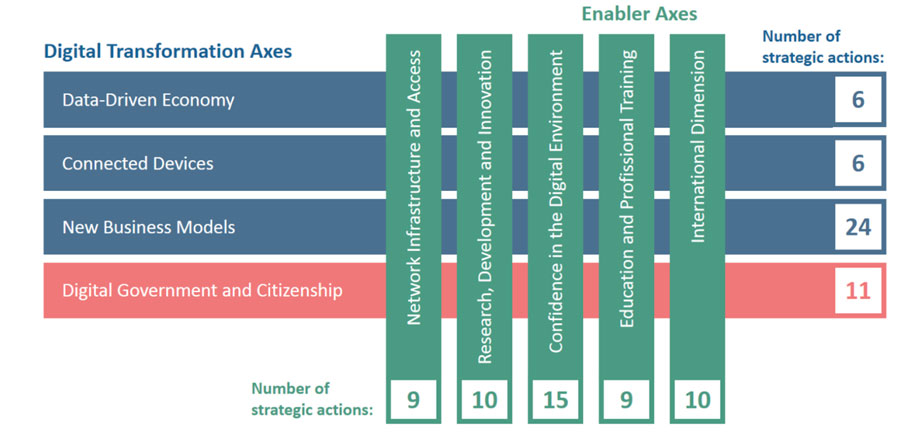 Image Source: Brazilian Digital Transformation Strategy
Image Source: Brazilian Digital Transformation Strategy
Brazil’s startup landscape
Data from the Brazil Startup Ecosystem Overview shows that the performance of Brazilian startups ranks first in South America and 26th globally.
According to the Associação Brasileira de Startups 2022 startup map, The Southeast region (56%) and the state of São Paulo (36.3%) are the main demographic locations of the interviewed startups. Followed by the southern region (24.9%) and Santa Catarina (9.4%). The two segments that stand out are edtechs, education startups, which appear in first place with 14.5%, followed by fintechs with 9.1%.
 Image Source: Mapeamento do Ecossistema Brasileiro de Startups
Image Source: Mapeamento do Ecossistema Brasileiro de Startups
São Paulo holds the country’s largest technological movement, with a lot of innovative and technological development that has been recognised worldwide; according to the Acate Tech Report 2021, Sao Paulo generates 48.4% of the country’s IT sector revenue, and the city is in the process of digitising public management and the urban experience.
São Paulo is home to 2,770 startups, including 11 unicorns valued at $1 billion or more. The University of São Paulo is ranked in the top 100 in the World University Rankings, providing a talent pipeline for businesses. São Paulo hosts the innovation and data centres of global titans such as Microsoft, Google, and Facebook and is also the regional headquarters for Airbnb, Netflix, and Amazon. It is also the Latin American base for many of the world’s biggest banks, improving access to capital for the city’s growing companies.
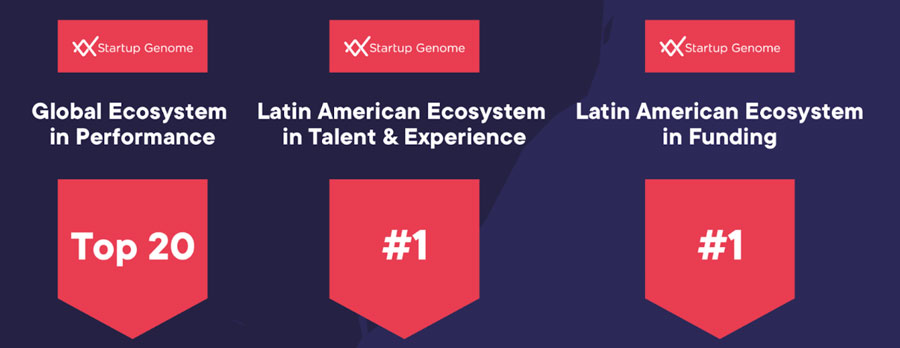 Image Source: Startup Genome
Image Source: Startup Genome
According to data by Startup Genome, when compared to 2020, the dollar amount of Series B+ rounds in Brazil increased by 237% in 2021. Accordion to the Corporate Venture Capital by Distrito, Investments fell sharply in 2022, only reaching 4.46 billion, compared to US$ 9.8 billion raised in 2021. Despite the drop, the figure marks the second-best year for the sector. The report also points out that, from the point of view of investors, the most attractive sectors were fintechs (US$ 1.7 billion), retail (US$ 500 million) and energy (US$ 300 million).
Through the diversification of capital ventures and the adoption of high-interest rates, the field of investments has growth potential. Brazil continues to lag behind countries with more mature capital investments, and the majority of investments in the technology industry were based on the business of founders, family, and friends.
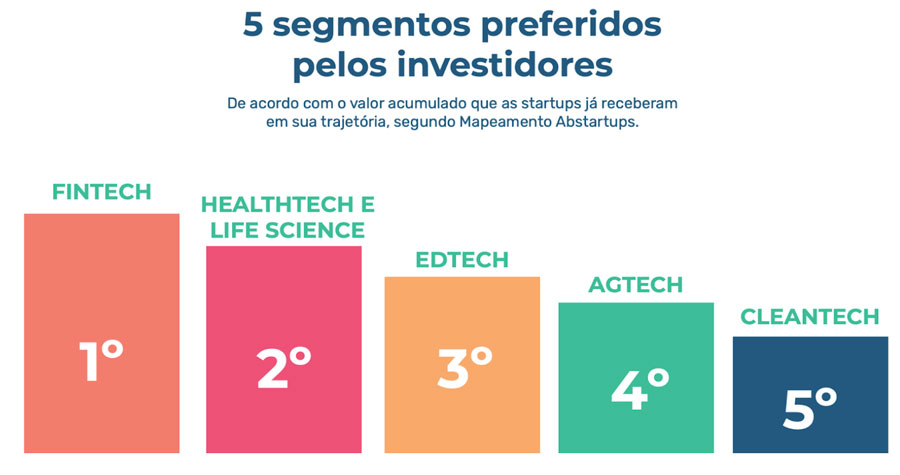 Image Source: Report Investimento 2022
Image Source: Report Investimento 2022
The region’s hottest innovation hub has a strong unicorn presence, a powerful fintech sector, and record startup funding figures. The cosmopolitan vibe, the size of the domestic market, and the public and private support networks all contribute to entrepreneurship in São Paulo, which has an expanding well-established ecosystem.
São Paulo’s startup ecosystem has experienced rapid growth thanks to various factors, including government support, funding opportunities, and a pool of talented individuals. The Brazilian government has launched more than 20 initiatives to support startups, including the largest acceleration program in Latin America, InovAtiva Brasil. São Paulo also offers low-interest credit facilities to startups, attracting investors and entrepreneurs from around the world. For example, Desenvolve SP is an initiative by the government offering credit facilities to businesses in São Paulo. The city also has a concentration of talented individuals, making it a hub for tech giants and providing a variety of options for startups looking to hire. As a result, the number of new jobs in the technology sector is growing, from an estimated 5,300 in 2022 to 6,600 job opportunities in 2023.
According to the Startup Ecosystem Report 2022, São Paulo is ranked fourth in the world for fintech hubs. With a total of 166 fintech companies, this sector dominates the city’s startup scene. They also received more than one-third of the total investment in 2021.
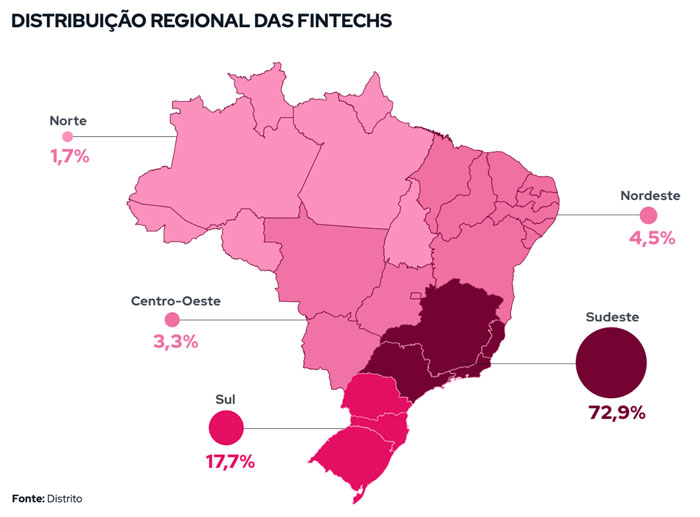 Image Source: Fintech Report 2022
Image Source: Fintech Report 2022
Brazil is well suited to fintech innovations due to its small banking system, oligopolistic nature, and changing consumer preferences. Fintech start-ups have quickly jumped in to provide a suite of fintech products, and the widespread use of payments for purchases began in the 1950s with the popularisation of ‘crediários’. The government has also provided initiatives to foster greater competition in the banking and payments sectors, such as ending the duopoly enjoyed by the dominant credit card acquirers in 2010 and reducing the fees that retailers pay for credit and debit card transactions. This has resulted in savings being passed on to the consumer, ending a period of supernormal profit for the acquirers.
Brazil’s fintech startup landscape is also heavily supported by the state. For example, the Brazilian government created the Legal Framework for Startups, and the Central Bank of Brazil launched a national regulatory ‘sandbox’ (a space for testing new business models that are not yet covered by current regulations).
Brazil’s fintech scene truly exemplifies how necessity breeds innovation. Brazil may provide a partial roadmap to the future of financial innovations in emerging markets, particularly the significant strides made in making the financial system more competitive, digital, and inclusive.
Education Startups, or ed-tech, are also leading the way in Brazil’s tech landscape. According to a report on the country’s ed-tech market, by the Brazilian Startup Association (abstartup), the country has registered 449 EdTech startups in 2019, a 23% increase compared to data collection in 2018. The state of São Paulo is home to about 35% of them. As of December 2020, a total of 559 edtech startups are operating in the country. According to the 2022 edtech map report, most edtech startups are in the traction or scale-up phase.
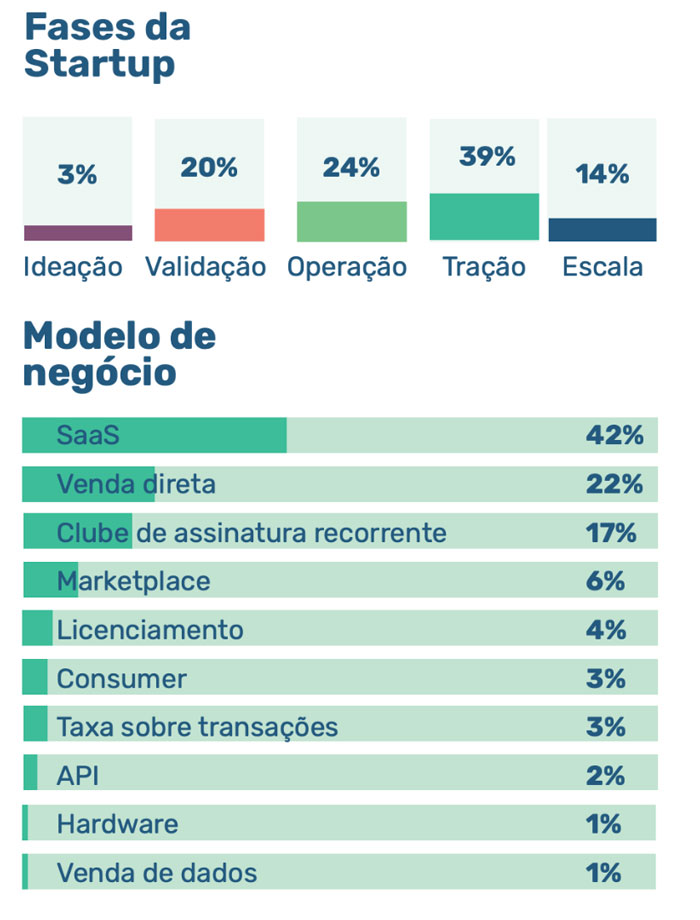 Image Source: Mapeamento Edtech 2022
Image Source: Mapeamento Edtech 2022
According to the Teched Distrito Report 2022, Edtechs are responsible for employing more than 35,000 employees, either directly or indirectly, and it is interesting to note that more than 40% of the workforce sector is allocated to startups focused on education platforms.
Workplace gap: existing problem between supply and demand in digital technology
The tech industry’s growth is accelerating, and with it comes a proportional increase in the talent required to support that process. The Brazilian tech industry employs more than 1.3 million people, but there are around 48,000 open vacancies, and businesses are struggling to find qualified candidates.
The demand for skilled tech workers will worsen in the following years, as it’s expected to continue growing. The following graph illustrates the need for new talent in the market from 2021 to 2025:
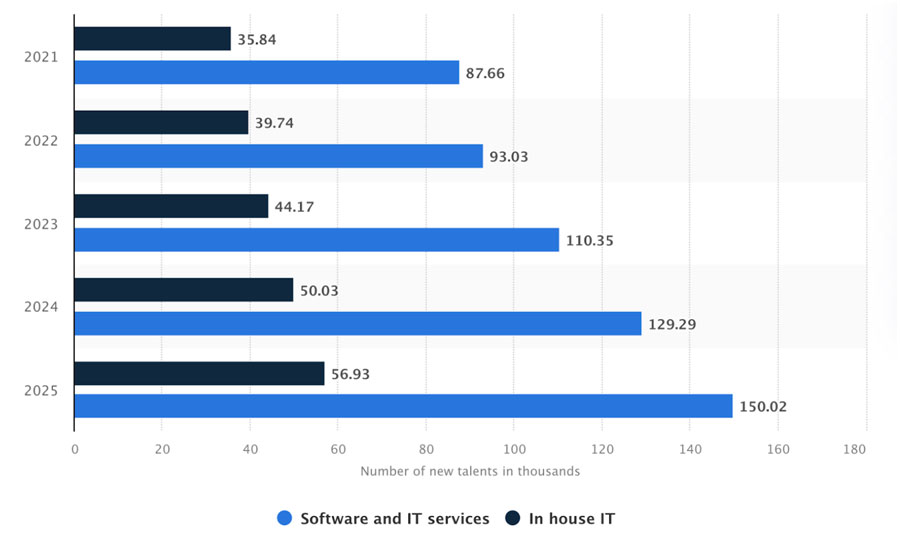 Image Source: Statista
Image Source: Statista
According to the Manpower report on Brazil’s 2022 talent shortage, the country’s talent demand has increased in the last three years, with the country reaching the highest talent shortage figures in the last 16 years in 2022, with 3 out of 4 employers finding it difficult to fill their workforces because they cannot find the required talent, accounting for 75% of the total. IT professionals are the most in-demand, despite not being the only market with talent shortages.
Multiple strategies are being developed to try to close the current supply-demand gap, but the problem is expected to worsen, and according to data from the Brazilian Association of Information and Communication Technology Companies (Brasscom), the issue could partly start in the education pipeline. Their data suggests that by 2024, the demand for tech talent could reach 70,000 per year, but the number of graduates will be 46,000 people.
According to Mckinsey’s report on Brazil’s digital market, the country appears to have a more significant gap between graduates and market demand than other countries such as the United States, Germany, Estonia, or India. In Brazil, for every student studying technology, there are eleven more graduates studying law or business.
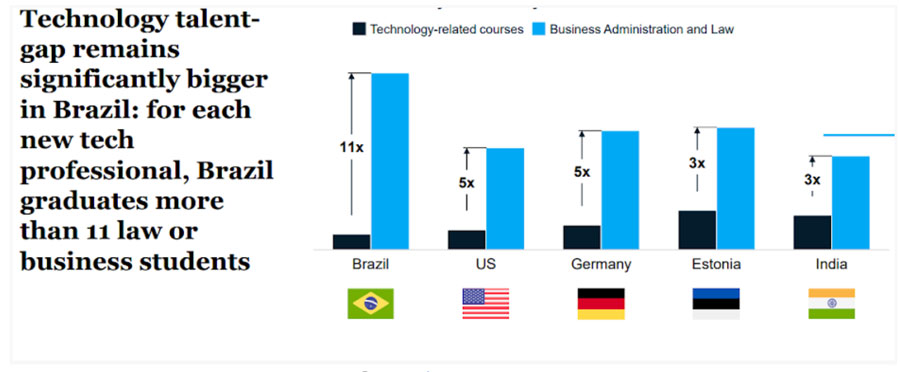 Image Source: Brazil Digital Report
Image Source: Brazil Digital Report
According to this report, there is a significant challenge in terms of skills where the training provided by Brazilian universities may not align with the market’s demands, as the report suggests tech education in Brazil is largely focused on academia.
Brazil also faces the challenge of retaining its existing talent supply as it competes with recruitment in other countries. The United States and European countries are among the ones that hire much of the Brazilian talent, offering more competitive salaries, a
stronger currency, and attractive working conditions, such as remote work. The lack of incentives to keep talent in Brazil, along with reduced government investment in education and science, are some of the reasons why people seek new opportunities outside the country. Therefore, Brazilian employers should offer similar working conditions, including salary and flexibility, to be more attractive.
The Great Resignation is a phenomenon that has been observed globally, and Brazil is no exception. As the Covid-19 pandemic took a toll on businesses and workers alike, many people took the opportunity to rethink their career paths.
According to the study commissioned by Você S/A from the data intelligence studio Lagom Data, Brazil has a high unemployment rate that translates into almost 13 million people looking for work. Despite this, Brazil’s talent market has not been immune to voluntary resignations: on average, almost 500,000 workers resign their jobs voluntarily a month, and the numbers keep going up.
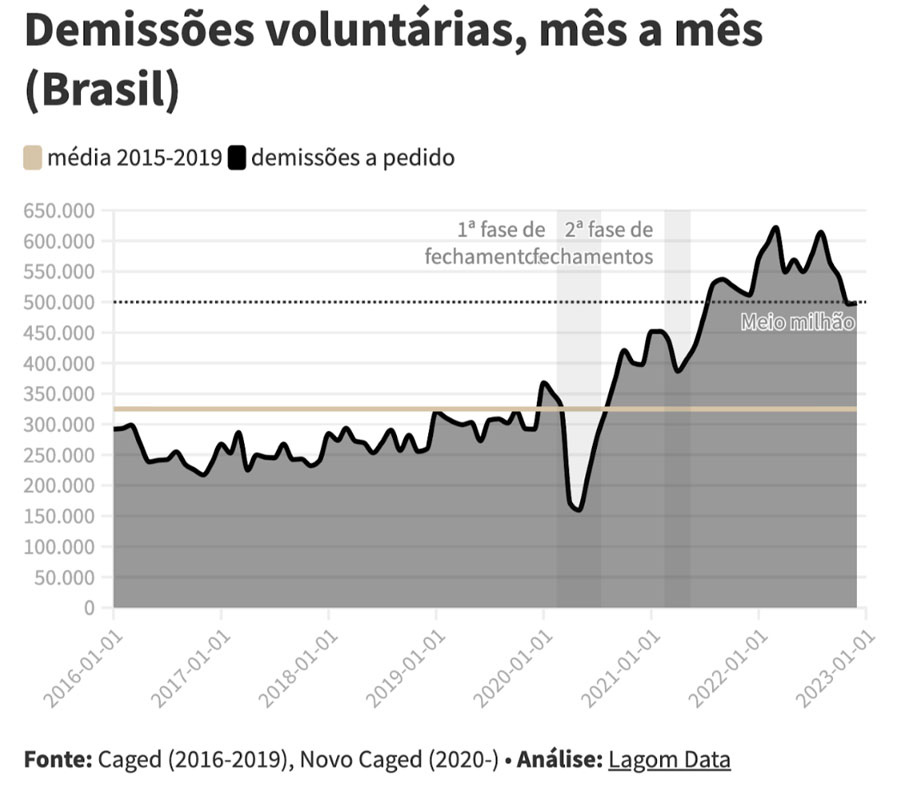 Image Source: Vocesa
Image Source: Vocesa
This situation has led to a highly competitive job market, where employers are struggling to retain their existing talent and attract new employees. Companies are now adopting various strategies to keep their employees engaged and satisfied, including offering flexible work arrangements, better benefits, and increased salaries.
As expected, the phenomenon does not affect the entire population but rather a privileged group of people who are generally young, male, have a high level of education and do not face significant difficulties in re-entering the labour market. The majority of resignations were filed by workers with a formal contract.
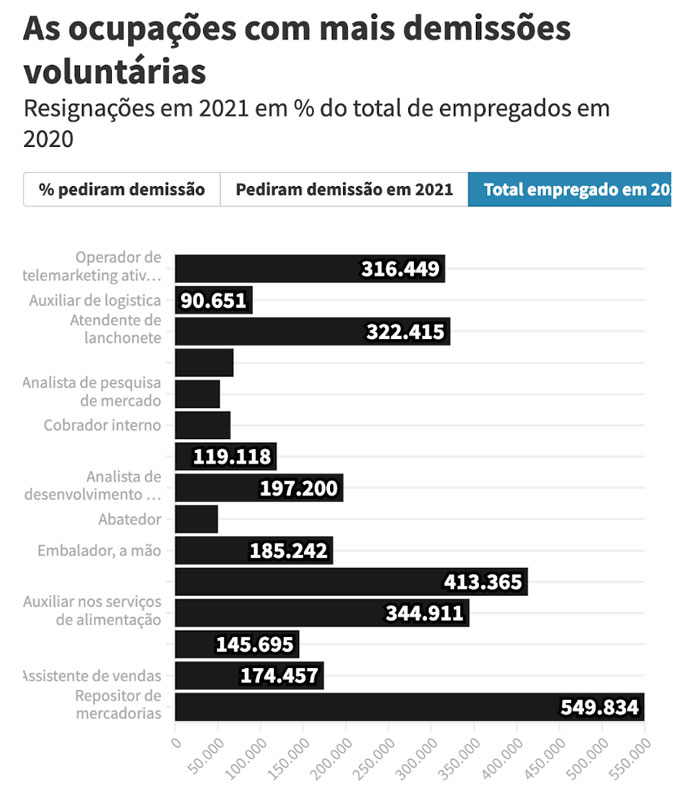 Image Source: Vocesa
Image Source: Vocesa
Brazilian’s great resignation, as observed, is one where a skilled and experienced workforce resigns and looks for better working conditions and more flexible work models. This can be explained by many factors: poor company culture, access to flexibility experienced during the Covid-19 lockdowns and a better work-life balance.
Employers and employees in a balance
According to Robert Half’s Salary Guide, 68% of surveyed employers believe it’s increasingly challenging to hire professionals with good qualifications. On the other side of the market, employees believe the pandemic and rapid digitalisation has permanently altered what they expect from future employers.
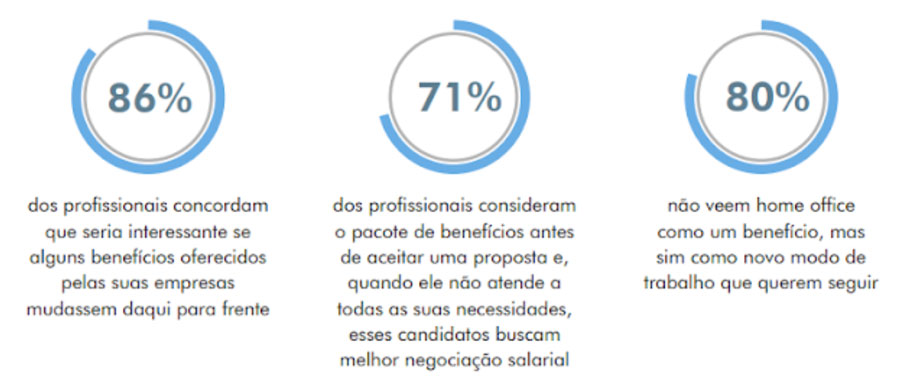 Image Source: Guia Salarial 2021
Image Source: Guia Salarial 2021
According to a global study on work-life challenges across generations, the majority of millennials quit motivated by the need to find a work-life balance, and the new generations are no longer only interested in the economic aspect but also in their personal fulfilment. The adaptability of new work models has resulted in new dynamics and relationships with work. Hybrid and remote work models have influenced the attraction of talent to more flexible models as part of new working models.
To attract and retain talent in Brazil’s changing landscape, companies need to adapt to the expectations and needs of today’s workforce:
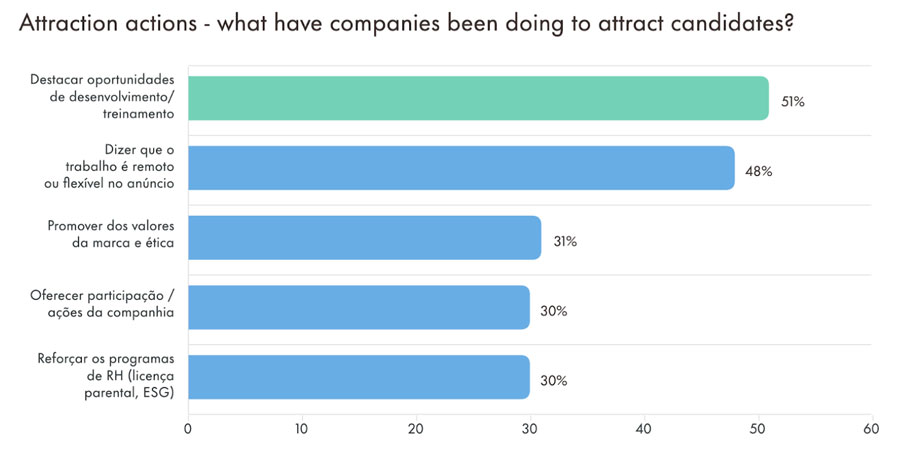 Image Source: Robert Half
Image Source: Robert Half
Reskilling and upskilling as a key:
One of the best company strategies to find and retain top talent is to reskill or upskills employees that show potential in particular skills and for hard-to-fill vacancies.
The concepts of reskilling and upskilling involve retraining or upgrading skills, either from scratch or improving existing abilities.
Deloitte Brasil’s Agenda 2022 data indicates that 9 out of 10 companies will increase or maintain their investment in specialised training in order to maximise their chances of obtaining the necessary skills. This reskilling strategy not only addresses the shortage of talent in the tech sector but also offers an alternative for workers in a challenging environment of high uncertainty and unemployment.
In order to address the skill gap, the technology industry and the Brazilian Association of Information Technology and Communication Companies (Brasscom) have proposed a joint training program to address the demand for web development skills. The program aims to train 156,000 web developers through selected educational institutions and edtechs as part of a pilot initiative. Brasscom’s research indicates that the sector requires around 420,000 new tech workers by 2024.
In today’s fast-paced and ever-changing business environment, companies are increasingly looking for employees with a mix of both hard and soft skills. While hard skills are still essential for technical-level jobs, it is the soft skills that help professionals thrive in their roles and contribute to the success of projects.
By finding employees who have diverse skillset, companies can build dynamic teams that are equipped to handle complex challenges and contribute to a positive work environment.
 Image Source: Tech Report 2021
Image Source: Tech Report 2021
Gender gap. How big is the gender gap in the digital tech industry, and how is it affecting the sector?
Despite numerous efforts in some sectors to promote equity and inclusion, there is still a tendency to think of technology as a typically masculine industry; socially learned preconceptions of what is typically masculine and what is typically feminine have had a significant impact.
According to Brasscom, 424,000 women will be working in the tech industry in 2021, accounting for 39% of all professionals in the sector. Still, only slightly more than 20% will be in tech-related positions.
The majority of them work in support or administrative roles. Women outnumber men in administrative and call centre HR positions, with 65.4% being female. Women make up 55.2% of the finance industry, while men make up 44.8%: sales, marketing, and legal account for 52.5% of the total.
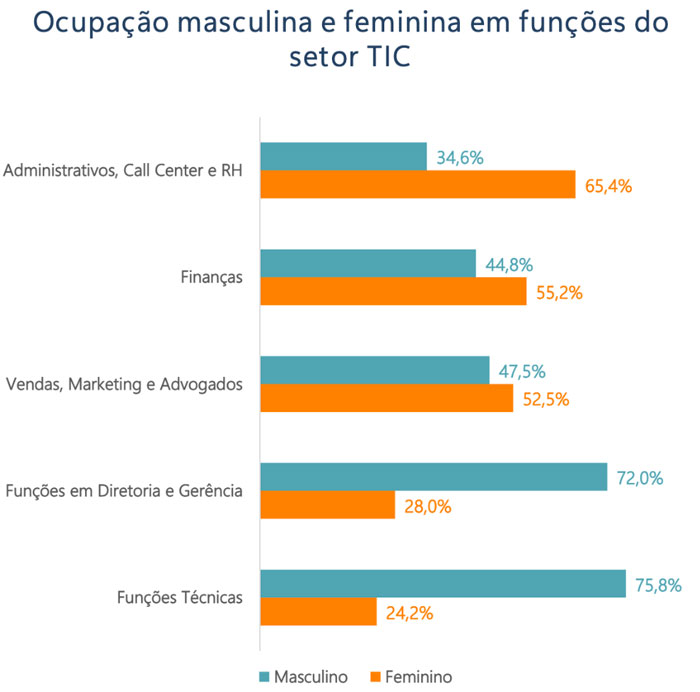 Image Source: Brasscom
Image Source: Brasscom
Mariana Carvalho is the co-founder of Brazilians in tech, and organisation that connects and supports Brazilian women who are studying and working in technology-related fields. She explains how women have actively participated in the tech industry for decades, but they are usually diminished by male counterparts who hold most of the decision-making power. More specifically, in Brazil, she adds:
“We also ome from a place where women didn’t have access to their finances until 1964, in Brazil. Until 1963, women didn’t have the right to have a Document ID. Without a Document ID, women couldn’t open a bank account, relying on partners and fathers to detain the power of their finances. Financial independence is a new concept for women in general.”
Many social preconceptions have shaped the incorporation of women in the technology sector, and stakeholders are working hard to make the industry a model of inclusion and diversity, but there is still much work to be done.
According to the Brazilian Association of Information Technology Companies (Brasscom) «women still represent only 20% of the country’s technology professionals, and 21% of technology teams in Brazil have no female representation. That is despite the predictions from Brazil’s Institute of Applied Economic Research (Ipea) that women should outpace men in terms of participation in the Brazilian workforce in the next decade».
Not only is there a lack of gender diversity in technology teams in Brazil, but the teams also continue to embody stereotypical ideas of those who work in the technology industry, predominantly composed of men and white individuals.
A report by diversity initiative Preta Lab in collaboration with consulting firm ThoughtWorks found that 68.3% of technology departments in Brazil are comprised of men, and 58.3% are made up of white individuals.
The lack of diversity in the Brazilian tech landscape is urgent, as the industry continues to grow and demand more professionals, it becomes crucial to welcome more people.
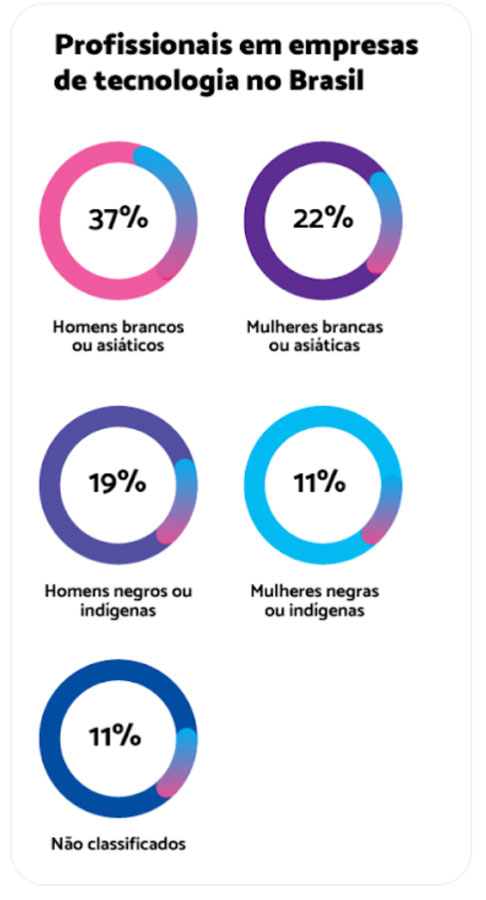 Image Source: Pretalab Report 2022
Image Source: Pretalab Report 2022
The representation of black women in IT teams in Brazil is alarmingly low, with only 11% of teams comprising black women. Additionally, the Preta Lab report found that one in three participants does not have a black person on their team.
This lack of diversity is not limited to gender but also extends to the black population in Brazil. As a result, tech teams in Brazil need to reflect the country’s population as a whole.
The problem of underrepresentation and lack of diversity in tech teams in Brazil has gained significant attention in the media and public eye. Mariana Carvalho commented on a viral photo depicting a team consisting mostly of white men.
“One famous startup here posted a photo with the team. It’s a big startup, it’s XP and they posted a photo of the employees and there were no black people. And the term we use is they were canceled in social media. So they were famous topic for weeks” .
The concept of creating a welcoming and inclusive work environment is essential for any company that wants to prioritise diversity and equality. By fostering a culture of respect and inclusivity, companies can ensure that all employees feel valued and empowered to contribute to the company’s success.
This, in turn, leads to a more productive and positive work environment where employees are motivated to do their best work and feel a sense of belonging. Moreover, an inclusive work environment is essential to creating more inclusive products and services. When teams are diverse, they bring a variety of perspectives and experiences, which can lead to more innovative and thoughtful solutions that cater to a wider range of customers.
Bridging the gap in any organisation requires a multifaceted approach. Providing information and education about diversity and inclusion is essential, but it is equally important to implement clear policies that outline specific measures and strategies for creating an inclusive workplace.
By establishing actionable steps and setting clear goals, organisations can create a supportive environment that fosters a sense of belonging for all employees. These efforts can also improve the organisation’s reputation and help attract a more diverse pool of candidates.
Ongoing monitoring and evaluation of the policies and strategies can ensure that progress is made towards creating a more equitable workplace. About this, Carvalho adds :
“Many organizations are already implementing guidelines, and programs and tracking KPIs to change their environments to have a more diverse and inclusive environment for women in the digital space; however, if this is not done with intention, it is hard to change. Leaders need to be intentional when implementing programs, male leaders need to sponsor and advocate for underrepresented groups in their companies. also, mentorship and sponsorship programs so women can shadow other women in their organizations also, establish quotas for underrepresented groups”.
Tech education and women entering the workforce:
Regarding gender stereotypes and how young women choose their career paths, Mariana Carvalho explained:
“Lack of influence and encouragement from families and parents. The patriarchy ideas: women go to Nursing school, and men go to Engineering school. Girls are taught to be perfect, boys are taught to be courageous. If we don’t change how society teaches girls and boys how to approach life, passions and careers, it is challenging to change how to create and increase the pipeline to have more women in the tech/digital world”.
The effects of gender stereotypes are apparent in the underrepresentation of women in STEM fields. Preconceived notions regarding traditional gender roles continue to play a significant role in career selection, with women being encouraged to pursue soft-skill careers associated with home care while men are more likely to pursue hard-skill careers, including those in STEM.
These stereotypes continue to impact career selection, as evidenced by the low number of women in STEM fields. Research shows that in 2019, 74% of STEM graduates were men, and 26% were women. The representation of women in the STEMs is lower than that of men, but the presence of white women in the STEMs is much higher than that of black and mixed-race women.
 Image Source: Women in STEM Labor Market in Brazil
Image Source: Women in STEM Labor Market in Brazil
Mariana Carvalho believes that great efforts are due to attract more female interest to STEM-related fields, and she suggests some essential initiatives:
“Investing in programs at the university level to encourage women to do Research, Development, Internships, and travel abroad for education (a partnership between organizations and the public sector to achieve this goal)” .
It is not just the lack of women in STEM that is a problem, but also the challenges they face when applying for jobs or working in the field. Women often encounter biases that hinder their progress and success. To address this issue, promoting inclusive work environments and reducing biases in the hiring process is crucial. Creating policies that support diversity and inclusion can help attract and retain female talent in STEM fields.
Moreover, organisations can provide training to help employees identify and overcome unconscious biases and ensure that recruitment and promotion processes are fair and transparent. By fostering a supportive and inclusive work culture, we can create a more equitable and diverse STEM industry.
Mariana Carvalho points out:
«Job descriptions are not inclusive. A study by Openreach showed that bias in job descriptions could deter 50% of candidates from applying for STEM (Science, Technology, Engineering and Mathematics) jobs. Changing job descriptions to more inclusive language increased applications from women by more than 200%”.
To reduce bias in the interviewing process, it is crucial to explore alternative approaches that can promote diversity and inclusivity. One such approach is to conduct anonymous interviews, which can be especially effective for women interviewees who may be subject to gender bias. By anonymising the interview process, candidates can be evaluated solely on their qualifications and experience rather than their gender or any other personal characteristics.
New technologies can also play an important role in reducing bias in the interviewing process. For instance, some companies are using artificial intelligence (AI) to screen resumes and identify top candidates based on their skills and qualifications. This approach can help to eliminate unconscious bias by removing personal information such as name, age, and gender from the screening process.
Mariana Carvalho uses this example:
“Jobecam is a software company that helps Brazilian recruiters hire candidates efficiently and without bias”.
Creating more inclusive spaces in the workplace is crucial to attracting and retaining women employees. One effective strategy is promoting work-life balance and quality of life, which has been identified as a major factor affecting women’s participation in the workforce. Traditional gender roles that associate women with home and childcare responsibilities can hinder women’s growth and retention in the workplace.
Providing flexibility for women employees is essential to ensure they can balance both their personal and professional lives. Organisations can implement policies such as flexible working hours, remote work, and job sharing to accommodate the needs of women employees. These strategies not only benefit women but also promote a healthier work environment for all employees.
Female leadership
The disparity between male-only and female-only founded companies is significant, with the number of companies founded solely by men almost 20 times greater than those founded exclusively by women, according to data from the Female Founder Report, by Distrito.
Despite research demonstrating the positive impact of female leaders in the innovation ecosystem and within companies, the growth of startups co-founded by women remains slow and limited in scale, with little progress seen over the past decade. This slow growth rate, regardless of the absolute number of female founders, means that achieving parity is unlikely, given the size of the disparity between male and female-founded companies.
While men continue to dominate the startup market, recent studies have shown that diversity is becoming an increasingly important issue for innovation companies. According to research, although the majority of startups are founded by men, 71.3% of these companies now have women on their staff, accounting for 41.9% of total employees. Furthermore, the study found that 22.2% of employees are black or brown, while 6.6% are aged 50 or over.
Despite the growing recognition of the importance of diversity, however, the research also revealed that many companies are failing to take action. While 60% of those surveyed agreed that supporting diversity is crucial, a significant 58.2% admitted to not having any action or selection process in place to promote diversity. This indicates that more work is needed to ensure that startups prioritise diversity and take active steps to promote inclusivity in their hiring and management practices.
Encouraging and attracting women to the technology industry involves more than just providing training and empowerment to occupy technology-specific positions. It also involves creating opportunities for women to assume leadership positions within the industry.
When women hold leadership positions, they become role models for other women who aspire to build careers in technology. Having more women in leadership positions also promotes diversity, as they bring different perspectives and experiences to the decision-making process.
When women are underrepresented in leadership positions, it can perpetuate the cycle of gender imbalance within the industry. Women may not see themselves reflected in leadership roles, which may lead to a lack of motivation to pursue such positions. Moreover, without female leaders driving change, there may be a lack of understanding of the unique challenges and barriers that women face in the industry.
“Role models that can encourage other women to be seen and heard in these positions” ,
said Mariana Carvalho.
What do experts say?
Fernanda Ruiz, graduated in Social Communication with a major in advertising and an MBA in Strategic Planning and Management. She is currently a specialist in Human Resources Management and works as a tech recruiter.
According to her perspective, technology has evolved to optimise time and boost productivity, contributing to the rapid expansion of the tech industry. A few factors that foster growth and innovation in this sector are the fast-paced nature of the tech industry, where something can become outdated within just six months, and the emphasis on effective communication and continuous learning within the IT field, which further fuels growth and innovation.
Jose holds a degree in business administration and has been involved in the technology industry since the 1980s. His experience started with the introduction of microcomputing in Brazil, and he quickly became interested in developing automated routines to improve efficiency. Throughout the years, he has worked on various projects, including the development of ERPs, and has also worked as a consultant. With a postgraduate degree and a passion for studying technological innovations, he also became a university professor. Currently, he works as a project manager, focusing on maintaining project quality and utilising knowledge in cloud computing, the Internet of Things, artificial intelligence, and big data processing.
Marcio has been a software developer for almost 20 years. He founded a small software consulting company which provides services for various companies, particularly early-stage startups. He leads a team of 10 to 12 people, and for the last five to six years, he has been working in startups of varying domains and sizes, ranging from 50 to 150 people during early and scale-up stages.
The tech industry and its changes
Our interviewed experts agree that this is an exciting moment for Brazil’s tech industry, with everything changing and innovating at a rapid pace. They believe that Brazil has the potential to become a global technology leader, as the country is currently experiencing a surge in entrepreneurship, investment, and innovation. The experts point out that Brazil’s tech ecosystem is becoming increasingly diverse and inclusive, with more opportunities for women, minorities, and underrepresented groups. They also highlight the importance of collaboration and knowledge-sharing among different players in the industry, including startups, corporates, academia, and government. Overall, the experts are optimistic about the future of Brazil’s tech industry and see great potential for growth and impact.
Jose explains:
» I have for myself a vision of an upward spiral processing capacity increases, the volume of processes and data increases, the need for memory increases and everything restarts at an ever-increasing speed. Since the beginning of my career, I have followed innovation on a time scale that started in an average of 3 years, and today it is in 3 to 4 months».
As technology continues to evolve at a rapid pace, professionals need to keep up with the changes. Fernanda Ruiz emphasises that staying updated is crucial to find the right candidate for any position, even for those who are not directly involved in the technical side of the business.
«IT is constantly evolving and requires constant updating. I read IT updates, books and articles on a daily basis, on Kindle and IT portals. The profile of technologies has changed. The cloud has become much more present and so has open-source development. Professionals just want to work remotely”.
The evolving industry demands a different set of skills, and the Covid-19 pandemic has brought about changes in the way people work. Professionals now seek remote or flexible work arrangements, and employers need to adjust their expectations accordingly. Fernanda explains how the pandemic has transformed the industry and the permanent changes she can now observe:
«The main change I felt was the possibility to work from home. Remote working is here to stay. Professionals have a strong resistance to face-to-face or hybrid work and often don’t even evaluate this hiring format. The pandemic has had a profound impact and continues to demand change. Some companies are investing in the development of internal social networks and other forms of team interaction. Companies reluctant to work remotely will be affected by the lack of technology professionals».
The industry is embracing worker-friendly models that promote labour flexibility and inclusivity. The employee-employer relationship is also shifting towards creating comfortable and supportive environments. One trend is to include the employee experience as part of the compensation package. On this aspect, Fernanda Ruiz says:
«Employee Experience actions for the employee to experience, observe, feel and share as part of your company. Improving the employee experience can help attract and retain talent”.
Furthermore, the industry’s changes have resulted in new organisational cultures that prioritise agile methodologies, which provide a better work-life balance. The traditional waterfall work model is being replaced with a more adaptable workflow that emphasises continuous evaluation and improvement processes. Fernanda comments:
«While Waterfall uses a defined and inflexible process, Agile methodologies encourage teams to improve and adjust their workflow as needed. Professionals are looking for flexible working hours, work-from-home performance, and aspire to a higher quality of life. Technology industries have changed, and they have been forced to do so. In the past, the professionals work in person at a desktop machine, clocked in, worked for hours, weeks or months, and then had their work evaluated. Today, the professional can work remotely, with a laptop, anywhere in the world, with continuous monitoring, which offers the possibility of improving or modifying deliverables before the end of the project, avoiding errors and allowing them to be corrected».
Marcio believes the Brazilian tech industry is growing faster than ever, and he highlights the growth of the Fintech sector:
“It’s the technology for financial services here in Brazil is a trend and I guess half of the companies. There are being created, for provide financial services, and the technology involved. It’s, it’s a trend”.
According to Marcio, one of the most significant changes in the tech industry in Brazil is that, after much growth and rapid hiring, some large startups are undergoing readjustments, creating an environment of hiring uncertainty. In this scenario, tech talent is changing their preference to apply to reputable and bigger companies.
Soundbite:
Another challenge for the Brazilian market is the recruitment of Brazilian talent by foreign companies, particularly developers. Foreign companies hire the most qualified English-speaking talent. Local talent prefers to be paid in stronger currencies such as dollars or euros, posing a challenge for local employers who cannot compete with foreign currencies. Marcio adds about foreign companies hiring Brazilian talent:
Soundbite:
This brain drain exacerbates the already existing talent shortage, making it difficult for companies to find and retain skilled workers, especially in emerging fields such as artificial intelligence and data science. As a result, companies are increasingly looking to invest in training and development programs to attract and retain talent in Brazil’s tech industry.
Supply and demand: the needs of the market
Brazil is currently facing a significant shortage of tech professionals, which can be partly attributed to a gap between the supply and demand of talent. The quality of basic education in the country has been identified as a contributing factor to this problem, as many students enter university without adequate preparation. As a result, a lower number of graduates are equipped with the skills and knowledge needed to meet the demands of the rapidly growing tech industry.
Regarding the lack of specialised education, Fernanda Ruiz, commented:
«The difficulty of entering public institutions promotes the search for private universities where the teaching is deficient. Some courses are riddled with old languages that are obsolete and will soon be retired, such as ASP, Delphi, C++. Other courses do not show the different aspects of computer science and all the possibilities of performance, training raw professionals without practical knowledge”.
Jose also adds to this:
«Newcomers are not prepared, not updated. studies are not practical, very theoretical and they have lack of soft-skills…».
This training gap has put pressure on companies to develop new strategies to address the talent shortage. One trend that has emerged is the hiring and training of students to meet the demand for skilled professionals. By investing in their own training programs, companies can adapt the training to the specific needs of the market and ensure that graduates have the skills necessary to meet the demands of the industry.
Fernanda says:
«Some companies hire junior professionals for a trial period, providing them with training and education, and those who stand out are hired».
Our expert suggests that a Bootcamp or an immersion program may be another key to addressing the talent shortage. These programs provide immersive training that can quickly equip individuals with the skills and knowledge needed to succeed in the tech industry. By offering intensive training in a short period of time, these programs can help bridge the skills gap and prepare individuals for careers in technology. Fernanda Ruiz, who is a specialist in tech recruitment, explains:
«It has become commonplace in education to define a type of intensive and accelerated learning in a wide range of areas, especially in IT. Bootcamp uses practical projects as if it were real, contracted jobs in a company”.
As new strategies for training talent emerge, biases within the industry become apparent, with a preference for candidates who have a background or previous work experience in technology. This preference can lead to a lack of diversity in the hiring process, as candidates from different fields or with different experiences may be overlooked. Marcio, for example, explains that:
“I personally look for product people who know or have previous experience in technology. As I said, they were putting in the market product people with trainings of only two months, but you cannot get a technical background just in two months. And one thing that I used to try to identify when hiring product people is I was looking for a technical background because it’s important”.
For Marcio, competition is fierce, and candidates from big universities will find it easier to enter the Brazilian job market.
The shortage of tech professionals in Brazil is also felt in the recruitment process, with many junior professionals seeking to migrate to more senior positions without possessing the necessary skills. This lack of preparation can lead to difficulties in finding the right candidate for the job, and companies may need to invest in training and development programs to bridge this gap. Fernanda shares her opinion:
«Professionals who get a first opportunity in the area in a short time as trainees, migrate to a Junior level position and after 2 or 3 years, they want to occupy a Senior position, but they do not have the experience to do so. Mid level professionals are almost extinct in the market».
Career changers
The current job market has evolved significantly, with people opting to change jobs more frequently, especially in the younger age groups. The trend of staying with one job for a lifetime has faded away, and employees seek better opportunities to improve their work situation. According to research, from the age group of 50 to 64 years, professionals tend to stay in the same job for about 10 years, whereas a quarter of young people aged between 18 and 24 years stay in a company for less than three months.
The emergence of new job expectations and preferences has further fueled the trend of career changes. Employees are actively searching for work environments that offer better pay, growth opportunities, or a fresh start in their professional lives. In this regard, the technology industry is one of the most preferred career choices, given the rapidly changing nature of the industry and the increasing demand for skilled professionals.
Take, for instance, J, a young Brazilian man who has undergone multiple career changes. Initially, he trained to work in international logistics, but he faced difficulty in finding a job. He then shifted to teaching English but soon realised he was being underpaid. Therefore, he switched to another field in search of better opportunities. This trend of frequent job changes has become increasingly common and is likely to continue.
About the challenges he faced in pursuing his career, J. shares:
Soundbite:
The changing job landscape offers opportunities for people to improve their working conditions and salaries. In Brazil, many people also leave their jobs to seek better opportunities in other markets, with the USA and European markets being popular destinations. This trend of Brazilians seeking better conditions abroad has become more prevalent in recent times.
Regarding looking for work in other markets, J. commented:
Soundbite:
The Covid-19 pandemic has had a significant impact worldwide, leading to job losses and prompting many workers to explore new areas of knowledge and training. For our interviewee, the pandemic has consolidated the idea of changing careers. J. commented on how the pandemic impacted his decision to become a career changer.
Soundbite:
Certain skills can facilitate a smooth transition to a new career, while other skills can help individuals grow within an industry that is undergoing constant change. According to J., developing these skills is crucial in making a successful career change.
«To switch careers, in order to keep growing and learning you have to have motivation… And yeah, open mind you must be open. Minded. And you always be learning things that you don’t like in the beginning. But then, You start liking or not but you must have open mind. Motivation, open mind and yeah, open to challenges».
The interviewees who have made a career change generally express satisfaction with their decision, highlighting positive aspects of their new roles. Some may not necessarily love the work they do, but they are happy with the higher salaries and increased flexibility. Others have found the change to be excellent, not only because of the financial benefits and flexibility but also because working in technology has reignited a passion for problem-solving.
On his personal experience in the tech field, J. commented:
However, some of the interviewees did mention some negative aspects of working in the technology industry, such as stress and pressure in certain training or work environments where there is a high demand for work. Some organizations are struggling with how to manage these burdens and maintain mental health in order to balance work and quality of life.
Trends by sectors:
Web development:
In April 2022, software and web developers, programmers, and testers accounted for the majority of tech-sector hiring trends in Brazil, making up 91.41% of all hires. This comes as no surprise considering the software market is expected to reach $6B in value by 2026
Looking ahead, developers are expected to remain the most in-demand profiles in the industry, with growth expected in the development of web applications and products. Latin America Trends to Watch for 2023 predicts that Brazil will have sales and investment performance above the global average, with e-commerce being more popular among women and young people in the region.
With the emergence of new technologies such as AI and augmented reality, there will be a shift towards developing products that offer more user-focused, immersive experiences, complementing the physical brand experience. However, the industry is facing uncertainty and changing scenarios, leading to an increased demand for more senior developer profiles that can deal with the challenges ahead.
For instance, the demand for developers with software skills in the .NET platform has risen by 33% for senior-level positions in Brazil; according to Programadores Brasil, developers are among the 5 Fastest Growing Technology Professions in Brazil. The industry is seeking all types of developer profiles, but the emphasis is on recruiting senior profiles who can navigate the evolving landscape.
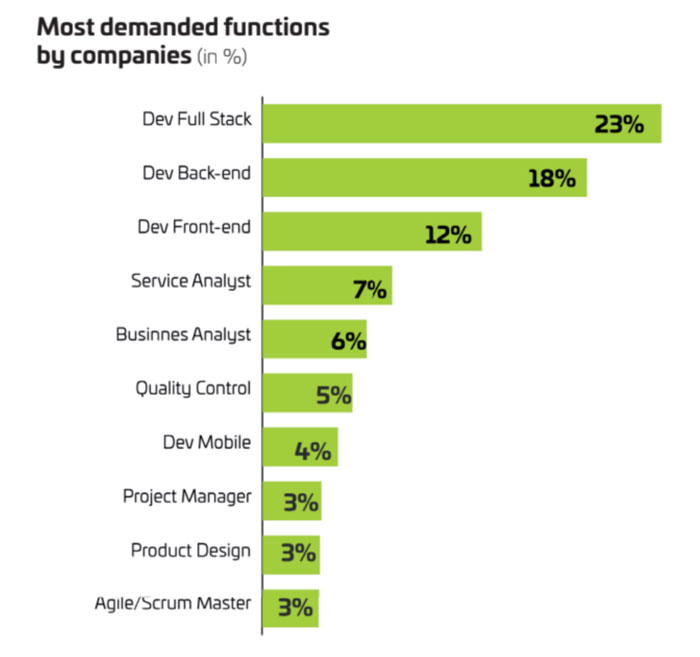 Image Source: Tech Report 2021
Image Source: Tech Report 2021
Tecla’s analysis shows that Brazil has become a potential market for talent acquisition in the region.
The country’s large pool of software developers, fair developer rates, high-education standards, and proximity to the United States make it attractive for many US-based startups interested in outsourcing software development projects or recruiting skilled developers. In fact, Brazil has around 25,000 IT companies, making it an ideal place for the North American market to search for new talent.
To succeed in the industry, developers require expertise in programming languages, software architecture and engineering, problem-solving skills, logical reasoning, and a results-oriented mindset.
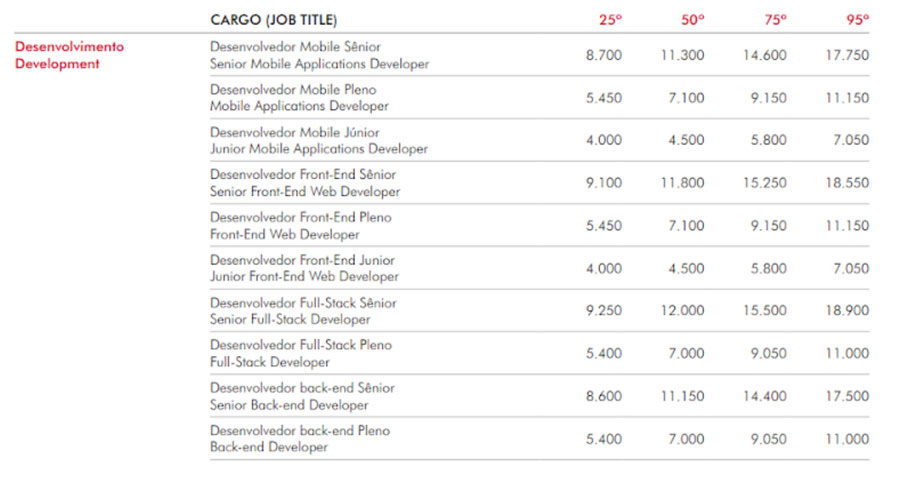 Image Source: Guía Salarial 2021
Image Source: Guía Salarial 2021
As for salaries, the average base salary of a developer with moderate experience is BRL 5,505.00 per month, although the amount can vary between BRL 4,000 to BRL 18,000 depending on the level of expertise.
Data Analysis
Data is poised to continue its rapid growth as one of the most prominent trends in Brazil in the coming years. In recent times, the integration of data into business management has become essential. In fact, investment in big data and analytics saw a 10.8% increase from 2021 to 2022. Additionally, investments in data centres rose by 17% year-on-year, amounting to BRL 4.3 billion (USD 850 million), highlighting the strong demand for core Internet infrastructure and services.
 Image Source: Brasscom
Image Source: Brasscom
The rise of data-driven organisations has brought about numerous commercial and business opportunities, making it one of the most promising new technologies. As data usage continues to expand, there is expected to be a significant increase in the hiring of data analytics-focused professionals. According to data from April of 2022, database and network administrators, as well as systems architects, accounted for 3.91% of all tech talent hires.
This article from Exame, «Estes 46 cargos estarão em alta em 2023, segundo o PageGroup«, discusses the impact of digitisation on data usage, stating that «the growth of digitalisation in companies and the evolution of data analysis tools, the area has become strategic, generating increasingly accurate analyses and ensuring greater assertiveness in the conduct of business.»
To be a successful data scientist or analyst, one must possess skills such as business understanding, statistical analysis, communication, and proficiency in languages like Python, Java, and R. Knowledge of machine learning and neural networks is also desirable.
According to Indeed.com Brasil’s «15 profissões na área de TI», the average salary for data scientists and analysts is between 5.379,00 BRL and 7.092,00 BRL per month. According to Robert Half, senior and specialist positions can earn around 8,000 to 17,000 BRL, and may even reach up to 26,000 BRL.
 Image Source: Guia Salarial 2021
Image Source: Guia Salarial 2021
As the use of data continues to grow, it will enter more mature phases that require regulation to ensure the ethical and unbiased development of applications. Experts have raised concerns about the risks of data use, and there is a trend towards increased laws to protect information and prevent bias and vulnerabilities in technology. For instance, Article 20 of the General Law on Data Protection (LGPD) allows people to request an explanation of the data system.
Cybersecurity
As consumer transactions increasingly shift towards social media and e-commerce, organisations are ramping up their digital presence as part of their business infrastructure, creating new vulnerabilities.
SonicWall reported that Brazil had over 33 million intrusion attempts in 2021, making it one of the most targeted countries for ransomware attacks, ranking behind only the US, Germany, and the UK. As a result, there is a growing need for cybersecurity professionals to combat these threats. In response to the surge in cyberattacks, the majority of Brazilian companies increased their cybersecurity budgets in 2022, according to ZDNET.
While cybersecurity prevention is not yet at its highest level globally, there is an expectation that it will grow in proportion to the sector’s expansion, along with the demand for cybersecurity talent.
The most sought-after competencies for this role include solid knowledge of network and system security, the ability to adapt to changes, and analytical, communication, and problem-solving skills. According to a study by Robert Half, cybersecurity is projected to be one of the most promising job positions for the future, with positions such as security architects and data detectives in high demand.
 Image Source: Guia Salarial 2021
Image Source: Guia Salarial 2021
Due to the scarcity of qualified professionals, cybersecurity salaries are expected to be among the highest in the market. The average base salary for this position is BRL 6,770.82 – BRL 7,326.32 per month, with Sao Paulo offering the highest salaries and the trend being an increase in the future.
Product management:
The role of a product manager is becoming increasingly important and requires individuals who can manage a growing backlog, possess technological expertise, and have a solid understanding of business and user needs. The ideal candidate should have a strategic mindset with a focus on long-term goals, as these projects are critical to a company’s future technologies. According to Robert Half’s salary guide, there is also a rising demand for management positions to restructure operations, as well as for scrum master positions.
Communication, business sense, and negotiation skills are highly valued in this position, as it requires a big-picture perspective and the ability to define product features while managing the backlog using agile methodologies like Scrum and Lean. There is also a growing trend towards using agile tools to improve organisational processes.
Salaries for product managers vary depending on experience, with an average base salary of BRL 8,201 to R$ 10,000, and can reach up to R$ 14,000, according to the job platform Vagas.com.
 Image Source: Guia Salarial 2021
Image Source: Guia Salarial 2021
The need for leadership and management skills will not only focus on hiring leaders but also on implementing effective management tools. According to Deloitte, there is a predicted 96% increase in the adoption of management applications, systems and tools.
The demand for leadership positions will be evident at all stages of product development. Recruiters are seeking team leaders and managers instead of entry-level professionals. Due to the shortage of skilled professionals, there is a significant need for specialists in the market. Therefore, candidates who invest in certifications and specialise in specific areas will have a greater chance of being promoted and securing higher positions in the future, according to Programadores Brasil.
UX UI Design
UX and UI designer profiles are in high demand, along with developers. With the increasing digital presence of organisations, design profiles are needed for the development of websites and applications.
The retail sector is expected to experience significant growth in 2023, with the adoption of omnichannel models and the emergence of new shopping models. The e-retailing sector is also expected to grow by 12% per year until 2026, and the Covid-19 pandemic has had a significant impact on online consumer behaviour, with a much higher number of first-time online consumers than predicted.
However, the uncertain scenario also means that companies are looking for more specialised profiles who can wear multiple hats. According to UX Collective’s «UX Trends«, the gap between what’s taught in design school and the demands of a design job is wider than ever. Senior profiles must navigate the needs of the market with little room for error, while entry-level designers face increased competition in a shrinking job market.
The acquisition of knowledge will diversify as social media and digital presence impact not only business infrastructure but also the sources of training and education. Academic institutions will play a smaller role as other formats gain prominence.
UX Trends notes that the brevity and engagement-focused nature of the content on social media platforms can lead to a loss of context and history behind the information, with new designers more likely to hear about UX laws from influencers on Instagram carousels than from the original research.
Emerging trends in augmented reality, artificial twins, and immersive realities will require application design that keeps pace with these new technologies. The demand for more generalist profiles with broader knowledge will increase, as these professionals will need to be capable of developing 3D applications with immersive designs. As reported by Indeed.com Brasil, salaries for these roles range from BRL 2,500 to BRL 4,000 per month, depending on seniority.
Career development:
Robert Half predicts that the most in-demand positions for the future in Brazil will be related to cybersecurity, cloud, data, and developers, along with other areas such as business understanding. In the future, there is expected to be a high demand for data, cybersecurity, AI, and digital development.
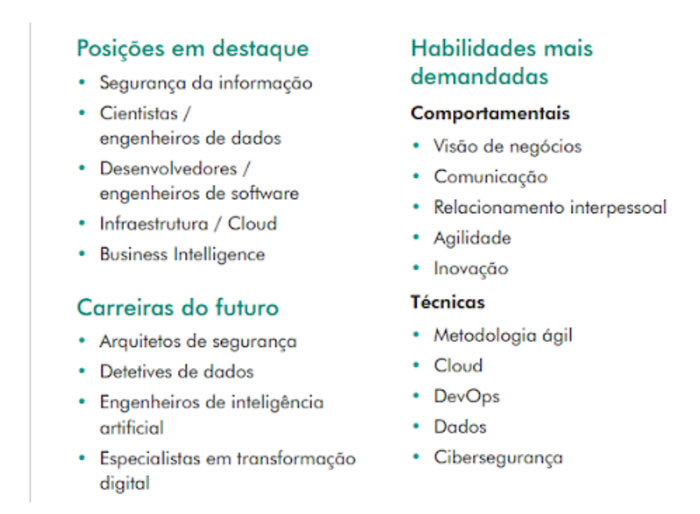 Image Source: Guia Salarial 2021
Image Source: Guia Salarial 2021
In the industry, skills related to data management, data protection, machine learning, artificial intelligence, and new technologies that optimise time and data will be highly valued. According to Michael Page, machine learning, data science, and data mining are important skills for improving business analysis and decision-making. Additionally, soft skills such as communication, people management, adaptability, and interpersonal relations will complement hard skills and be well-valued in the industry.
There are varying opinions regarding the skillset needed to be competitive in the Brazilian job market today. Due to the crisis, generalist profiles will be in higher demand than specific profiles. The Future of Jobs Report 2020 by Weforum suggests that profiles with tech skills will be more in demand in the medium and long term, while some other profiles may become obsolete.
It is certain that new technologies will become more prevalent, and professionals with knowledge in these areas will become increasingly relevant, requiring adaptation to these changes.
Reskilling and upskilling as a way to stay in the market:
The prolonged periods of uncertainty have left people feeling increasingly insecure. While new technologies bring new job opportunities, there is also a fear of automation in some areas. The rise of artificial intelligence has raised concerns about the future career paths of certain professions, such as UX designers.
According to the study «Decoding Global Reskilling and Career Paths,» concerns about automation were already prevalent before the pandemic, with younger workers being particularly worried. The study reports that 46% of those in their twenties and 41% of those in their thirties expressed increased concern about technology putting them out of work.
In the tech industry, reskilling can take two paths: reskilling in core business areas such as coding and development and reskilling in operational training with the automation of the industry. The implementation of Industry 4.0 will require both leaders to guide the automation process and workers capable of solving complex problems.
The study «Reskilling Revolution» reports that the fourth industrial revolution will have a significant impact on reskilling, not only in Brazil but also around the world. Deloitte explores the question of what work can be automated with increasing robotics, cognitive, and AI technologies.
The study «Decoding Global Reskilling and Career Paths» found that the top resources for reskilling were on-the-job training, self-study, and online educational institutions. Some interviewees reported that universities are no longer the main source of knowledge as academia struggles to keep up with the demands of the market.
New future trends and paradigm shifts
Latin America is forecasted to experience slow growth in the upcoming year. While Brazil’s economic performance in the coming quarters will depend on fiscal policy, investments in technology will remain a priority to cope with the uncertainty. Brazil is expected to invest heavily in technology, specifically in the areas of data and networking, cloud, big data, information security, artificial intelligence, robotics, blockchain, and virtual reality. The Internet of Things, artificial intelligence, cloud, and new technology investments will receive the most funding.
 Image Source: Brasscom
Image Source: Brasscom
According to «Latin America Trends to Watch for 2023,» there is an e-commerce growth opportunity in Latin America, surpassing the global average. Companies will invest heavily in social networks due to changing consumer behaviour, with digital presence increasing in the areas of digital security, customer marketing, and online sales channels.
Softex’s «Rumos da inovação para 2023 têm expectativas positivas» emphasises the importance of investing in user experience (UX), products, and services that have a positive social impact and focus on sustainability. Companies must be a part of a vast innovation ecosystem to share ideas and participate in innovation processes.
The shift from multichannel to N-commerce involves providing users with multiple channels that can adapt to their needs. Elcio Santos, executive director of Always On Data Science and Engineering, explains in the article «Do E-commerce para o N-commerce: como se tornar indispensável para o seu cliente» that «N-commerce is a business model that is based on the current consumer lifestyle.
Most consumers no longer have one or even two or three preferred channels – they have ‘n’ channels that they choose based on convenience and trust in the brand.»
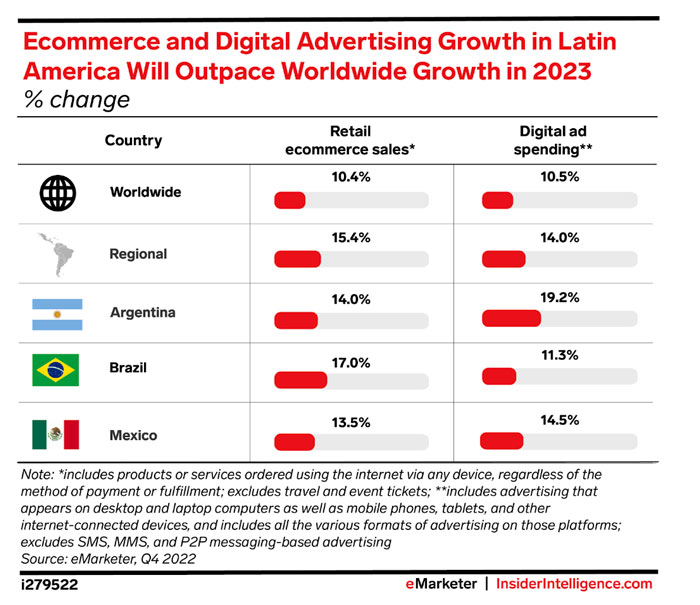 Image Source: Insider Intelligence
Image Source: Insider Intelligence
Investment focus in the future will prioritise the reduction of cyber risk and vulnerability, information security, and the automation and implementation of Artificial Intelligence (AI). According to a Brasscom study, AI is recognised as one of the primary technologies for 2021, with potential investments of US$ 464 million for Brazil. The growth of the AI market will continue to be driven by chatbots.
Increasing cybersecurity infrastructure is a priority for both the Brazilian government and the industry. Modernisation through automation, optimisation processes, and cost reduction. As per this study, the Edge Computing sector is expected to grow at a rate of 16% per year between 2019 and 2023.
Cloud is a crucial element of the IT infrastructure, and spending on Infrastructure as a Service (IaaS) and Platform as a Service (PaaS) in the public cloud is projected to reach US$ 3 billion, a 46.5% increase from 2020. The private cloud model is also on the rise, with US$ 614 million projected for 2021.
Talent and work
Recruitment and hiring in the industry are facing a lot of uncertainty due to recent events in the country, including the layoffs of large Brazilian companies with shares on the stock exchange, fear in the market, and unemployment of skilled labour. An article from the UX Collective platform suggests that 2023 is a year to cultivate certainty by innovating in a focused way on one’s business.
At least 21 companies, including Facily, Vtex, Olist, Mercado Bitcoin, Kavak, XP, Valemobi/TradeMap, Americanas S.A./B2W, Shopee, and iFood, have laid off more than 2,000 professionals since April. Human resources will see most of the changes in the sector. While talent shortage remains a major concern for the industry, SMEs will be doing most of the hiring.
The challenge of the talent war has led to the emergence of the services sub-sector in Brazil, which presents significant growth potential. Gaper.io, a recruitment consultancy, reports that the country has become an increasingly attractive market for IT talent, particularly for developers and engineers.
Industry changes have resulted in the development of a valuable pool of talent in Brazil, combined with the cost-effectiveness of leveraging the relatively low value of the Brazilian currency, making it an appealing prospect for North American and European markets.
Additionally, the pandemic and remote work have changed companies’ priorities and employer branding strategies. Deloitte’s studies show that companies are focusing on improving the employee experience by offering flexibility, aligning with social values like sustainability and diversity, as well as having clear goals and mission statements.
 Image Source: Deloitte
Image Source: Deloitte
The industry’s talent shortage will continue to be addressed through reskilling and upskilling strategies. While some interviewees emphasise the importance of staying current within their sector, traditional educational channels are no longer the only means to upgrade skills. Online training and digital sources have become prevalent, and alternative methods of obtaining information are emerging, such as collective platforms, networks, and influencers.
Key Opinion Leaders (K.O.L.) and referents come in various formats. Paulo Peres, Design Lead and Design Specialist, predicts that online education schools will grow even more due to the high supply of professionals available in the market (which has grown by 470% and is expected to represent 50% of the market). He also anticipates an increase in digital education, but not solely in the form of academia.
The changing nature of work will also impact job-hopping, with people seeking better working conditions and career changers undergoing reskilling processes. While high wages will remain an important attraction strategy, offering diverse working conditions and compensation benefits will continue to be a trend.
This approach will enable companies to attract talent from different locations, reducing operating costs. According to LatamList’s report, What the Tech Hiring Scene Will Look Like for Latin America in 2023, this trend is expected to continue in the near future.
The Covid-19 pandemic has allowed for experimentation with new work approaches while also changing expectations for companies, emphasising the importance of social responsibility. In Brazil, highly skilled employees are resigning not only due to salary but also because they don’t identify with the organisation’s values, which often lack an ESG strategy (Social, Environmental and Corporate Governance).
The article «How to treat the Great Brazilian Resignation?» by RECRUT.AI emphasises the role of ESG in recruitment processes, stating that new generations prioritise company purpose, inclusion, and ESG actions. Employees expect companies to have social responsibility and inclusive goals, and more individuals will be looking for companies that align with their values.
The Softex article «Rumos da inovação para 2023 têm expectativas positivas» notes that technological innovation and ESG gained strength in Brazil in 2022, and this trend is expected to continue in 2023, with growth in emerging technologies inspiring companies and attracting investment in R&D&I.
Student Testimonials
Ironhack offers an opportunity for career transformation to many students who enrol in the program to either reskill or upskill. While some participants come with a prior understanding of the tech industry and look to enhance their existing knowledge, others seek to shift their career paths for various reasons, such as dissatisfaction with their current roles, a desire for better job prospects, improved work-life balance, and overall well-being.
During this journey, friends, acquaintances, and coaches often serve as influential guides, playing a crucial role in shaping their path. Ultimately, the process of selecting a new career path, securing a job, and embarking on a new professional journey is a highly personal experience.
Adriano has been a career changer since his early working days.
Following a background in Digital Media and Technology, he decided to pursue a different path in the culinary world, which he has been developing for the past 14 years:
«First one is Digital Media and Technology, and the second one is Culinary Arts, and my career expectations were to open my own business in the food industry. I opened my own restaurant, and managed it for the last 14 years».
Adriano highlights that one potential solution for those seeking new career opportunities is relocating to another country with a more competitive job market. In such a move, the technology industry can be a particularly attractive sector, offering more and potentially higher-paying job options. He explains:
«I am in the process of moving from one country to another (Brazil to USA) and the tech field in the USA has good pay and it is a subject that I already had some familiarity with, from my first college degree».
According to other interviews with Ironhack students, there are various reasons why they choose the program. Some mention positive recommendations and the strong reputation of Ironhack within the ed-tech market, while others appreciate the option to complete the training in their native language or in English. Adriano shares his opinion:
«I choose Ironhack because of the price, and the possibility of doing it remotely using my native language (…..) «I chose this program Fullstack Dev because I already had some familiarity with the content».
He started the bootcamp with clear expectations: learn something new and find a well-paid job. His experience is, overall, positive, and Adriano describes the bootcamp as a “smooth” process, and when the bootcamp finished, he took advantage of extra free online courses until he found a job.
«The content we learn in the bootcamp is foundational knowledge. It’s enough learning for you to start to build and learn more on top of it. Without the bootcamp I would never have been able to learn coding by myself, but after the bootcamp, I can and I am able to learn new things. There are so many more subjects and technologies to learn after you finish the program, because the content of the bootcamp is foundational (important but not fully enough)».
Ironhack’s «Career Week» is one of the key strengths of their training, as most of the students have reported that the tips provided during this week were crucial in securing a job. However, there are areas where some students feel that they could have received more training to better prepare themselves for the job market, such as Relational Databases (SQL) and backend development.
Adriano suggested that the course could go more in-depth in the backend to ensure that students are better equipped for the workforce. Although the course is called FullStack, he feels that the current focus is more on the front end.
Conclusions
Brazil’s tech market is poised for long-term growth despite global uncertainty and anticipated downturns in the technology industry. The telecommunications and mobile usage market is so vast that it is expected to continue to grow. Fintech, healthtech, and agritech are among the key areas for startups in the country, with fintech being the fastest-growing technology sub-sector.
The tech industry’s projected growth is 30% until 2025. It is ranked in the top three economies for innovation in Latin America and the Caribbean, and its innovation performance exceeds expectations. The government is focused on expanding the industry by digitising the sector and creating Sistema Nacional dos Ecossistemas Brasil Digital.
The Brazilian startup ecosystem is healthy and growing. The Southeast region (56%) and the state of São Paulo (36.3%) are the main demographic locations of the interviewed startups, followed by the southern region (24.9%) and Santa Catarina (9.4%).
The two segments that stand out are edtechs, education startups, and fintechs. São Paulo holds the country’s largest technological movement, with a lot of innovative and technological development that has been recognised worldwide. It is home to 2,770 startups, including 11 unicorns valued at $1 billion or more, and is also the Latin American base for many of the world’s biggest banks. Investments fell sharply in 2022, only reaching 4.46 billion.
Brazil continues to lag behind countries with more mature capital investments, and the majority of investments in the technology industry were based on the business of founders.
While layoffs have caused uncertainty in the industry, the search for talent in the sector is expected to continue. However, two events impact Brazilian talent: foreign markets are attempting to recruit the best Brazilian talent with experience and English proficiency, and profiles are requiring improvements in work-life balance. Therefore, companies need to focus on improving the conditions of their employees to retain talent and remain attractive.
New technology trends, such as AI, cybersecurity, data, and cloud, may encourage the search for new profiles with specialised knowledge. However, according to some interviewees, the current uncertainty and problems necessitate more generalist profiles with soft skills such as business vision, leadership, and the ability to adapt to changing market demands.
Companies may use different strategies to look for talent, with some requiring junior profiles to reduce costs while others are seeking more senior profiles capable of handling various demands.

